Nvidia Announces Jetson Nano Dev Kit & Board: X1 for $99
by Andrei Frumusanu on March 18, 2019 7:00 PM EST- Posted in
- NVIDIA
- Tegra X1
- Jetson
- Jetson Nano
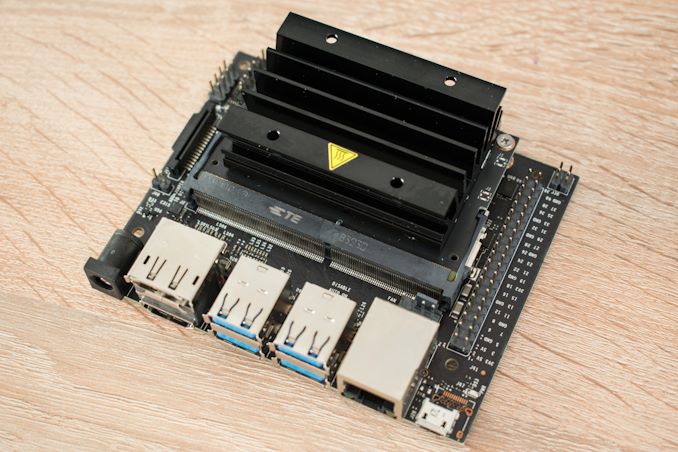
Today at GTC 2019 Nvidia launched a new member of the Jetson family: The new Jetson Nano. The Jetson family of products represents Nvidia new focus on robotics, AI and autonomous machine applications. A few months back we had the pleasure to have a high level review of the Jetson AGX as well as the Xavier chip that powers it.
The biggest concern of the AGX dev kit was its pricing – with a retail price of $1299, it’s massively out of range of most hobbyist users such as our readers.
The new Jetson Nano addresses the cost issue in a quite dramatic way. Here Nvidia promises to deliver a similar level of functionality than its more expensive Jetson products, at a much lower price point, and of course at a lower performance point.
The Jetson Nano is a full blown single-board-computer in the form of a module. The module form-factor and connector is SO-DIMM and is similar to past Nvidia modules by the company. The goal of the form-factor is to have the most compact form-factor possible, as it is envisioned to be used in a wide variety of applications where a possible customer will design their own connector boards best fit for their design needs.
At the heart of the Nano module we find Nvidia’s “Erista” chip which also powered the Tegra X1 in the Nvidia Shield as well as the Nintendo Switch. The variant used in the Nano is a cut-down version though, as the 4 A57 cores only clock up to 1.43GHz and the GPU only has half the cores (128 versus 256 in the full X1) active. The module comes with 4GB of LPDDR4 and a 16GB eMMC module. The standalone Jetson Nano module for use in COTS production will be available to interested parties for $129/unit in quantities of 1000.
Naturally, because you can’t do much with the module itself, Nvidia also offers the Jetson Nano in the form of a complete computer: The Jetson Nano Developer Kit. Among the advantages of the Kit is vastly better hardware capabilities compared to competing solutions, such as the performance of the SoC or simply better connectivity such as 4 USB full (3x 2.0 + 1x 3.0) ports, HDMI, DisplayPort and a Gigabit Ethernet port, along with the usual SDIO, I2C, SPI, GPIO and UART connectors you’re used to on such boards. One even finds a M.2 connector for additional WiFi as well as a MIPI-CSI interface for cameras.

Jetson AGX Dev Kit vs Jetson Nano Dev Kit
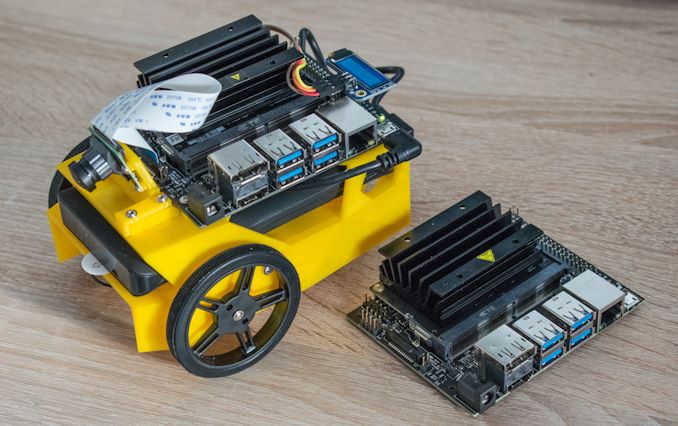
Jetbot with Jetson Nano Dev Kit vs Jetson Nano Dev Kit
The Jetson Nano Development Kit can be had for only $99. One way Nvidia reaches this price is through the omission of on-board storage, and the kit is driven purely by microSD card. Availability starts today.
We have the Jetson Nano in-house and will seeing what fun things Nvidia cooked up for us soon!


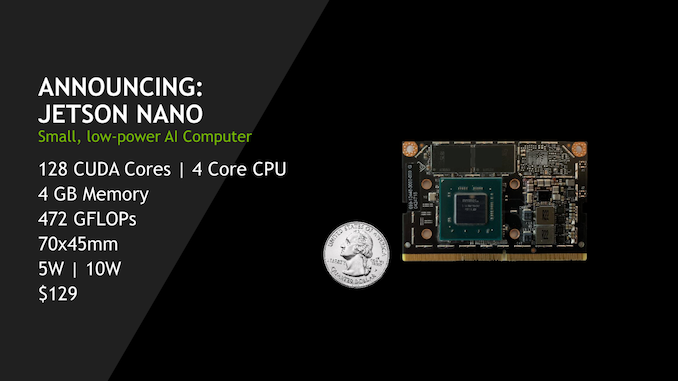
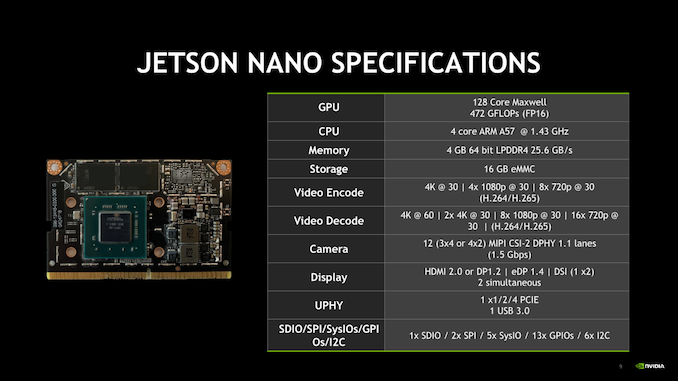

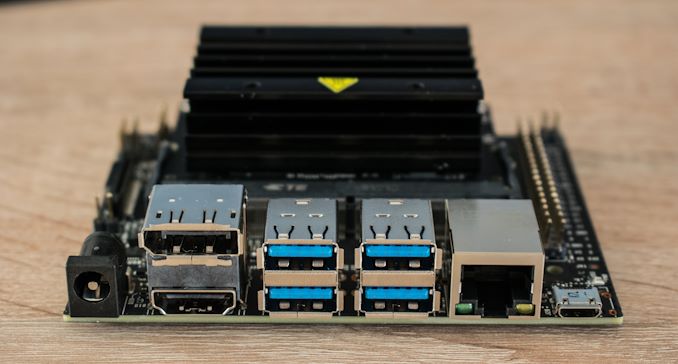
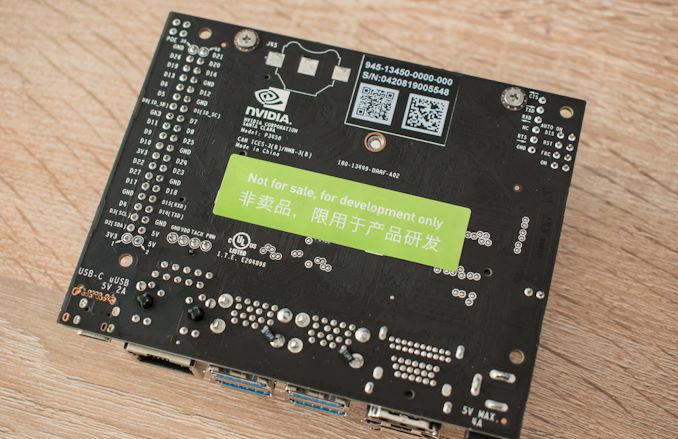








49 Comments
View All Comments
HardwareDufus - Tuesday, March 19, 2019 - link
not enough i/o.. sure I could string together a bunch of MCP3424s and MCP23017s together … but it would be nice to have more on board.wizfactor - Tuesday, March 19, 2019 - link
I'm also pretty excited about this SBC, especially since Raspberry Pi 4 is at least a year away. The spoiled brat in me wishes that they used ARM A76, but then again it's not often that an Nvidia product is sold below $100.I do worry about the fact that the drivers are proprietary, which means it's uncertain how supported this GPU will be in future versions of Linux. Will Nvidia make sure this SBC can run Ubuntu 20.04 and 22.04?
werpu - Tuesday, March 19, 2019 - link
Very likely since their blobs seem to be shared over the entire product range (which is industrial customers targetted)I do not expect to have driver support on full stop within a year given nvidias past and that those products are sold also for the industry.
However i also do not expect to see any decent opensource drivers for this stuff for decade long support. The thing is if you want to see that you have to go the amd route, but find me one Ryzen embedded board in the sub 150 Dollars range, there is none. And the only enduser Ryzen embedded board at all atm, was sold in limited numbers over Kickstarter.
@Amd if you read this, there are people who would buy your stuff, there is a market you fail to address despite having the processors.
Valis - Sunday, March 24, 2019 - link
Since this is not using any of the new A72-75, I would much rather get an AMD Ryzen 3 series when it comes out on M-ITX. Sure it's bigger, but the endless possibilities of Windows / Linux etc is far more useful.wizfactor - Tuesday, March 19, 2019 - link
Does anyone else think that Nvidia is trying to finish up their obligations to TSMC for 20nm products?Maybe a Nintendo Switch SoC refresh at a more mainstream node is imminent, and Nvidia is using this opportunity to sell a product based on the last of the 20nm wafers. Or perhaps the simpler explanation is that these dev boards are using Switch SoC rejects.
Still, these will likely make very nice SBCs.
werpu - Tuesday, March 19, 2019 - link
This is more like selling off semi working X1s which otherwise would have gone into the recycler.This is normal for most processor manufacturers who downbin silicon which did not pass the resptective tests, until the silicon passes the test for the respective downbinned product line.
werpu - Tuesday, March 19, 2019 - link
Btw. love it how they gave it another AI spin, while it is basically the processor in the Switch and Shield.frenchy_2001 - Thursday, March 21, 2019 - link
The same processor (full though, so more grunt) is in the original Jetson TX, which has been used for autonomous drones.Nv hypes the AI on it because they provide a full set of libraries that will run on it and use the GPU to accelerate it. No other SBC around that price has this.
This SBC has enough power to run some image recognition and AI NN for decisions.
Benaldo - Tuesday, March 19, 2019 - link
Can you run Retropie on it?edzieba - Tuesday, March 19, 2019 - link
O frabjous day! Callooh! Callay! If you've been looking for a home/small business mocap systyem between "dump several tens of grand for Vicon or similar" and "like, maybe a kinect isn't /tooo/ shite once you manually fix everything..." this is the board that's going to power it. 4 synced CSI inputs, and enough on-board processing to offload all image filtering tasks to the SoC and just feed streams of coords to the host PC. Other SBCs like the Raspberry Pi lack multiple camera interfaces (or have no ability to sync them like pair on the RPi Compute Module).